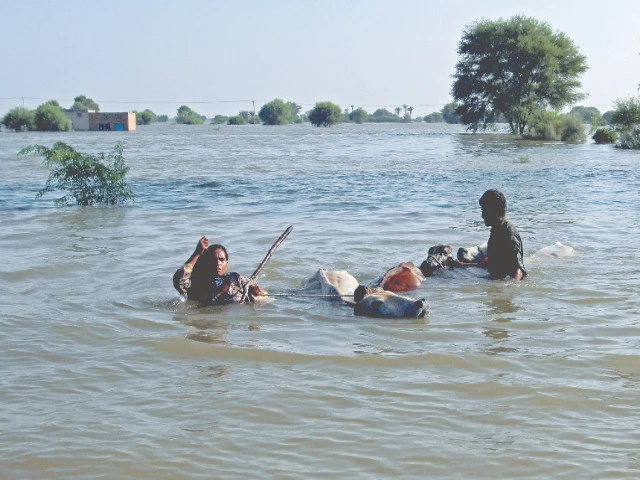New rain spell forecast from Sept 16
Floodwaters enter Sindh, raise water level in barrages

As the country reels from devastating floods caused by one of the most intense monsoon seasons in recent memory, weather officials have forecast a fresh spell of rainfall from September 16 to 18. The new rains are expected to affect Azad Jammu and Kashmir, northern and central Punjab, and parts of Khyber-Pakhtunkhwa.
Unlike the torrential downpours of August, the upcoming spell is likely to be of moderate intensity. Authorities are closely monitoring the situation and have urged local administrations to remain on high alert.
Meanwhile, officials have warned that districts including Multan, Muzaffargarh, Liaquatpur, and Rahim Yar Khan face heightened risk as India continues to release high volumes of water into downstream rivers.
According to the Provincial Disaster Management Authority (PDMA), protective embankments at Basti Baharan near Multan have collapsed, while a deliberate cut was made on the Uch Sharif road to protect the city from inundation. This move, however, left surrounding villages — Mouza Jhanbo, Nooraja Bhatta, Kotla, Bahadurpur, and Sabra — badly affected.
At Sher Shah dyke, water continues to press against the barrier, though the decision to breach the dam has been delayed after the immediate flooding threat in Jalalpur Pirwala temporarily subsided.
The situation at Head Panjnad remains alarming, with a massive flood wave of 607,000 cusecs flowing through. Earlier, nearly 70 percent of Alipur was submerged, leaving widespread devastation.
In Farid Shah near Qabulah, thousands of acres of crops have been destroyed and road links cut off, forcing residents to evacuate by boat. In Lodhran's Akbar Shah area, more than 2,000 houses are underwater, with cotton, rice, maize, and sesame crops completely wiped out.
The Arifwala region is also struggling against high floods in the Sutlej River, where displaced families are sheltering in makeshift camps, waiting for relief.
Meanwhile, in Tehsil Liaquatpur Narwala (Rahim Yar Khan), river water has entered areas that had been dry for decades, creating chaos and forcing mass evacuations. Local authorities have declared the protection of lives, livestock, and property their top priority.
At Head Panjnad on the Chenab, the flood has surged past 668,000 cusecs, moving rapidly towards Simka Chachran. Despite earlier signs of relief, the water level is rising again.
Additionally, Taunsa Barrage on the Indus River is recording a discharge of around 200,000 cusecs, while Trimmu Barrage is releasing 188,000 cusecs towards Sindh.
At Ganda Singh Wala, the Sutlej River is flowing at more than 182,000 cusecs, with Indian water releases continuing for the third consecutive day, further aggravating the crisis.
The Punjab Provincial Disaster Management Authority (PDMA) reported on Thursday a decline in water flows in most rivers due to reduced monsoon rains. Rainfall in the upper catchment areas has also stopped.
According to the PDMA, the water flow in the Sutlej River at Ganda Singh Wala was 182,000 cusecs, while at Sulemanki it stood at 124,000 cusecs. The Chenab River recorded flows of 50,000 cusecs at Marala, 92,000 cusecs at Khanki Headworks, and 94,000 cusecs at Qadirabad.
The Ravi River's flow was 23,000 cusecs at Jassar, 31,000 cusecs at Shahdara, 78,000 cusecs at Sidhnai Headworks, and 63,000 cusecs at Balloki Headworks. At Trimmu Headworks, the flow was 178,000 cusecs, while at Panjnad Headworks it stood at 660,000 cusecs.
Compared with the previous days, the flow has declined at Sidhnai and Trimmu Headworks but increased at Panjnad.
The Meteorological Department reported a significant rise in water levels at the country's major reservoirs.
Tarbela Dam has reached its maximum capacity of 1,550 feet, while Rawal Dam stands at 1,751.80 feet - almost at its full capacity of 1,752 feet.
Mangla Dam is 92 per cent full at 1,234.60 feet, and Simli Dam has reached its maximum storage of 2,315.25 feet. In response, spillways of all major dams have been opened to release excess water and protect infrastructure.
Sindh situation
The floodwaters that wreaked havoc in Punjab, have now entered the Indus River, causing a rapid increase in water levels at the Guddu and Sukkur barrages.
According to irrigation official on Thursday, over the past 24 hours, the water levels at both barrages have risen by thousands of cusecs.
According to the latest data, the inflow at the Guddu Barrage stands at 502,861 cusecs, while the outflow is 407,970 cusecs.
At the Sukkur Barrage, the inflow is 440,985 cusecs, and the outflow is 412,735 cusecs. The Kotri Barrage has an inflow of 257,754 cusecs and an outflow of 254,354 cusecs.
The rising water levels in the Indus River have inundated several areas in the kachha (riverine) region, with floodwaters entering numerous villages.


















COMMENTS
Comments are moderated and generally will be posted if they are on-topic and not abusive.
For more information, please see our Comments FAQ